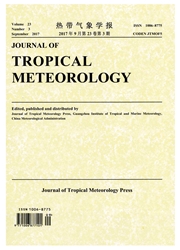

 中文摘要:
中文摘要:
Based on 6-hourly sensible heat flux and latent heat flux from the NCEP Climate Forecast System Reanalysis(CFSR) and circulation data from the Japanese 25-year Reanalysis(JRA-25),the initial developing process of tropical cyclone Mindulle(1005) in 2010 has been diagnosed to reveal the impact of air-sea interaction over the South China Sea(SCS) on the genesis of its incipient vortex.The results show that the incipient vortex first occurred east of the Luzon Island on 0000 UTC 20 August,suggesting that the topographic forcing of the Luzon Island for easterly winds over the western Pacific might be one of the factors responsible for the formation of the incipient vortex.During the formation stage of the incipient vortex,strong southeasterlies over the SCS caused warm water of the middle and eastern SCS to flow toward the Luzon Island due to Ekman transport resulting from wind stress,leading to an increase of the sea surface temperature and sensible heat flux into the atmosphere.Although the anomalous sensible heating favored surface pressure to reduce,it was not conducive to the increase of local vorticity associated with the vortex above the heating area because,according to the atmospheric thermal adaptation theory,the anticyclonic vorticity would be created in the lower troposphere due to the decreased vertical gradient of the sensible heating.However,the ascending motions occurred over the eastern area of the anomalous sensible heating due to the augmentation of the vorticity advection with increasing height,causing water vapor to condense in the middle and upper troposphere.In turn,cyclonic vorticity was generated in the lower troposphere due to the increased vertical gradient of the condensation latent heating,resulting in the formation and further growth of the incipient vortex.Therefore,the vorticity creation due to the condensation heating played a dominant role during the subsequent enhancing stage of the incipient vortex.
 英文摘要:
英文摘要:
Based on 6-hourly sensible heat flux and latent heat flux from the NCEP Climate Forecast System Reanalysis (CFSR) and circulation data from the Japanese 25-year Reanalysis (JRA-25), the initial developing process of tropical cyclone Mindulle (1005) in 2010 has been diagnosed to reveal the impact of air-sea interaction over the South China Sea (SCS) on the genesis of its incipient vortex. The results show that the incipient vortex first occurred east of the Luzon Island on 0000 UTC 20 August, suggesting that the topographic forcing of the Luzon Island for easterly winds over the western Pacific might be one of the factors responsible for the formation of the incipient vortex. During the formation stage of the incipient vortex, strong southeasterlies over the SCS caused warm water of the middle and eastem SCS to flow toward the Luzon Island due to Ekman transport resulting from wind stress, leading to an increase of the sea surface temperature and sensible heat flux into the atmosphere. Although the anomalous sensible heating favored surface pressure to reduce, it was not conducive to the increase of local vorticity associated with the vortex above the heating area because, according to the atmospheric thermal adaptation theory, the anticyclonic vorticity would be created in the lower troposphere due to the decreased vertical gradient of the sensible heating. However, the ascending motions occurred over the eastern area of the anomalous sensible heating due to the augmentation of the vorticity advection with increasing height, causing water vapor to condense in the middle and upper troposphere. In turn, cyclonic vorticity was generated in the lower troposphere due to the increased vertical gradient of the condensation latent heating, resulting in the formation and further growth of the incipient vortex. Therefore, the vorticity creation due to the condensation heating played a dominant role during the subsequent enhancing stage of the incipient vortex.
 同期刊论文项目
同期刊论文项目
 同项目期刊论文
同项目期刊论文
 Interannual variability of snow depth over the Tibetan Plateau and its associated atmospheric circul
Interannual variability of snow depth over the Tibetan Plateau and its associated atmospheric circul Interannual variations of early summer monsoon rainfall over South China under different PDO backgro
Interannual variations of early summer monsoon rainfall over South China under different PDO backgro Diurnal variations of summer precipitation over the Asian monsoon region as revealed by TRMM satelli
Diurnal variations of summer precipitation over the Asian monsoon region as revealed by TRMM satelli Different multi-fractal behaviors of diurnal temperature range over the north and the south of China
Different multi-fractal behaviors of diurnal temperature range over the north and the south of China Mechanistic Analysis of theSuppressed Convective Anomaly Precursor Associated with the Initiation of
Mechanistic Analysis of theSuppressed Convective Anomaly Precursor Associated with the Initiation of Changes in the borealsummer intraseasonal oscillation projected by the CNRM-CM5 model under the RCP8
Changes in the borealsummer intraseasonal oscillation projected by the CNRM-CM5 model under the RCP8 Interdecadalmodulation of ENSO-related spring rainfall over South China by the PacificDecadal Oscill
Interdecadalmodulation of ENSO-related spring rainfall over South China by the PacificDecadal Oscill 期刊信息
期刊信息
